

At the USGLC, we are champions of the International Affairs Budget (IAB), so one of the first things we discuss with our interns is the importance of these programs in supporting America’s diplomacy and development. At just 1% of the total federal budget, IAB programs are not only a strategic investment in advancing our country’s health, economic, and security interests, but also a return on investment. They play a critical role in battling the root causes of violent extremism and instability in other countries, respond to humanitarian disasters, and tackle pandemics like COVID-19. Moreover, international affairs funding is responsible for supporting agencies and programs that include the State Department, the United States Agency for International Development (USAID), the Peace Corps, and global health and foreign assistance.
Each semester, we recruit an ambitious team of interns to help advocate for American diplomacy and development around the world as well as the international affairs funding that supports U.S. global engagement. As a capstone of the internship experience, our interns dive into different aspects of the budget, researching an international affairs program of their own choosing and subsequently presenting their findings to the entire USGLC staff. Not only do USGLC’s interns learn more about these impactful endeavors, but they also develop professional skills like research, writing, presenting, and public speaking that will be useful in future career settings.
In their own words below, and in no particular order, our summer and fall intern classes of 2021 provide highlights of their presentations, helping show the range and diversity of U.S. international affairs programs and how their funding supports people globally and Americans at home.
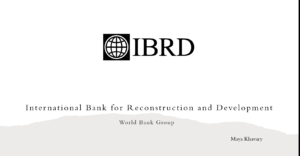 The International Bank for Reconstruction and Development (IBRD) is one of the four developmental institutions that constitutes the World Bank. IBRD’s main goal is to alleviate global poverty, and it does so by helping middle-income countries and creditworthy low-income countries promote sustainable development. The United States was a leading force in the establishment of the IBRD in 1944 and remains the largest shareholder of the World Bank Group today. IBRD raises most of its funds in the world’s financial markets, which has allowed it to provide over $500 billion in loans to alleviate poverty around the world since 1946.
The International Bank for Reconstruction and Development (IBRD) is one of the four developmental institutions that constitutes the World Bank. IBRD’s main goal is to alleviate global poverty, and it does so by helping middle-income countries and creditworthy low-income countries promote sustainable development. The United States was a leading force in the establishment of the IBRD in 1944 and remains the largest shareholder of the World Bank Group today. IBRD raises most of its funds in the world’s financial markets, which has allowed it to provide over $500 billion in loans to alleviate poverty around the world since 1946.
International financial institutions (IFIs) such as the IBRD have been, and remain, vital responders amid the COVID-19 crisis, with the ability to provide large-scale financing to countries with pressing financial needs. IBRD has several different projects around the world, including a partnership in India to transform the energy market for rooftop solar, supporting improved irrigation service delivery to almost 19,000 farmers in the Peruvian Sierra, and working with China to provide skills training for over 520,000 young people in rural China as well as providing employment services for over 4.2 million job seekers.
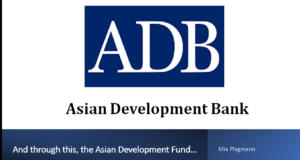 The Asian Development Bank (ADB) was established as a financial institution in the early 1960s to foster economic growth and cooperation in one of the most impoverished regions of the world. The ADB assists its members and partners by providing loans, technical assistance, grants, and equity investments to promote social and economic development. Additionally, the institution maximizes the impacts on development by facilitating policy dialogues, providing advisory services, and mobilizing financial resources through co-financing operations. The operational priorities of the ADB include eradicating poverty and inequality, gender inequality, making cities more livable, tackling climate change and disaster resilience, promoting rural development and food security, strengthening governance and institutional capacity, and fostering regional cooperation and integration. As part of its 2030 Strategy, the ADB envisions a prosperous, inclusive, resilient, and sustainable Asia and Pacific region, whilst sustaining efforts to eliminate extreme poverty.
The Asian Development Bank (ADB) was established as a financial institution in the early 1960s to foster economic growth and cooperation in one of the most impoverished regions of the world. The ADB assists its members and partners by providing loans, technical assistance, grants, and equity investments to promote social and economic development. Additionally, the institution maximizes the impacts on development by facilitating policy dialogues, providing advisory services, and mobilizing financial resources through co-financing operations. The operational priorities of the ADB include eradicating poverty and inequality, gender inequality, making cities more livable, tackling climate change and disaster resilience, promoting rural development and food security, strengthening governance and institutional capacity, and fostering regional cooperation and integration. As part of its 2030 Strategy, the ADB envisions a prosperous, inclusive, resilient, and sustainable Asia and Pacific region, whilst sustaining efforts to eliminate extreme poverty.
Since joining the financial institution in 1966, the United States Government primarily provides essential funding to the ADB via the Asian Development Fund (ADF) as a line item on the International Affairs Budget. The U.S. has contributed a total of $26.86 billion in capital subscription to the ADB as of December 31, 2020 and provided $4.85 billion to Special Funds such as the ADF since 1966.
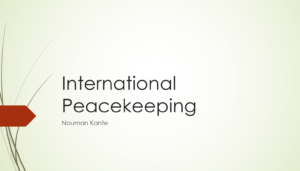 The United Nations is the embodiment of a continually evolving international order, and UN peace operations are the physical manifestation of that order. UN peacekeepers work diligently and cooperatively to bring peace and stability to the world’s most volatile conflict zones, protecting civilians from violence and securing and promoting human rights. UN peacekeeping began in 1948 when the Security Council authorized the deployment of UN military observers to the Middle East in an operation which became known as the United Nations Truce Supervision Organization (UNTSO). In 1956, the first UN peacekeeping entity, the UN Emergency Force, was deployed to Egypt to address the Suez Crisis. Since 1948, more than 70 peacekeeping operations have been deployed by the UN.
The United Nations is the embodiment of a continually evolving international order, and UN peace operations are the physical manifestation of that order. UN peacekeepers work diligently and cooperatively to bring peace and stability to the world’s most volatile conflict zones, protecting civilians from violence and securing and promoting human rights. UN peacekeeping began in 1948 when the Security Council authorized the deployment of UN military observers to the Middle East in an operation which became known as the United Nations Truce Supervision Organization (UNTSO). In 1956, the first UN peacekeeping entity, the UN Emergency Force, was deployed to Egypt to address the Suez Crisis. Since 1948, more than 70 peacekeeping operations have been deployed by the UN.
Although there is no international consensus as to what peace and security mean, the prevailing understanding is modeled by what and how peace operations are conducted. Without peace, it is difficult to create good, stable governance. As the international community works to prevent conflict from happening around the world, UN peacekeeping continues today to facilitate the political process, protect civilians, uphold human rights, and restore law and peace.
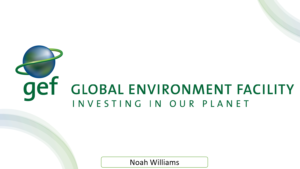 Grants from the Global Environment Facility (GEF) constitute the largest single funding source for environmental sustainability in developing economies. The GEF is an independently operated, multilateral financial mechanism that provides grants for environmental projects in partner countries, civil society organizations, and the private sector. GEF funding supports over 5,000 projects across the world protecting biodiversity, land, water, forests, combatting climate change, and more. The GEF has been instrumental in supporting adaptation to climate change in low- and middle-income countries as natural disasters and changing weather have put additional pressure on infrastructure and ecosystems.
Grants from the Global Environment Facility (GEF) constitute the largest single funding source for environmental sustainability in developing economies. The GEF is an independently operated, multilateral financial mechanism that provides grants for environmental projects in partner countries, civil society organizations, and the private sector. GEF funding supports over 5,000 projects across the world protecting biodiversity, land, water, forests, combatting climate change, and more. The GEF has been instrumental in supporting adaptation to climate change in low- and middle-income countries as natural disasters and changing weather have put additional pressure on infrastructure and ecosystems.
The United States is an important contributor to the GEF. Contributions from the international affairs budget have exceeded $80 million a year for the last decade and have been greater than $130 million for the past three years. On average, the United States represents 20% of the total global contribution to the GEF. As the world mobilizes to combat the effects of climate change, the United States has steadily increased its contribution, taking a crucial step toward the environmental stewardship necessary to cope with a changing climate.
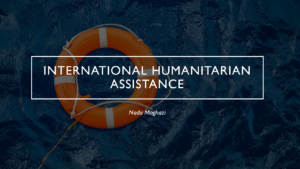 Humanitarian affairs should be at the forefront when discussing policies regarding our rapid globalization. As the world continues to develop, far too many nations continue to suffer from drastic humanitarian crises, often due to conflict, climate change, and the historical ramifications of colonialism. The United States holds a certain responsibility to invest in humanitarian assistance given its position as a global superpower.
Humanitarian affairs should be at the forefront when discussing policies regarding our rapid globalization. As the world continues to develop, far too many nations continue to suffer from drastic humanitarian crises, often due to conflict, climate change, and the historical ramifications of colonialism. The United States holds a certain responsibility to invest in humanitarian assistance given its position as a global superpower.
In an effort to reduce the amount of money brought into the three categories of “Disaster Assistance,” “Migration and Refugees,” and “Emergency Refugees,” President Trump proposed the consolidation of these three into one line item, known as International Humanitarian Assistance. Given the rapidly growing rate of global crises that require U.S. support, Congress rejected this effort to reduce the budget categories dedicated to humanitarian assistance. As climate change, conflict, and natural disasters continue to displace millions of people year-round, U.S. dedication to the promotion of humanitarian aid has never been more important. Moreover, with developing nations growing economically and socially, it is in the United States’ interest to invest in these sectors to grow the global economy and strengthen alliances, further supporting globalization, interconnectedness, and humanity.
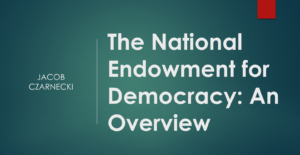 The National Endowment for Democracy (NED) is an independent, non-profit foundation dedicated to strengthening democratic institutions and human rights promotion. Founded in 1983 under the Reagan Administration, NED allocates grants civil society organizations in nearly 100 countries around the globe. As a grant-making organization, NED does not administer these programs themselves. Instead, it provides grant funding to its partners who carry out NED-supported programs on the ground. These unique characteristics provide greater operational flexibility than most federal programs, enabling work with smaller, newer organizations and within repressive states that would otherwise hesitate to take U.S. government funding.
The National Endowment for Democracy (NED) is an independent, non-profit foundation dedicated to strengthening democratic institutions and human rights promotion. Founded in 1983 under the Reagan Administration, NED allocates grants civil society organizations in nearly 100 countries around the globe. As a grant-making organization, NED does not administer these programs themselves. Instead, it provides grant funding to its partners who carry out NED-supported programs on the ground. These unique characteristics provide greater operational flexibility than most federal programs, enabling work with smaller, newer organizations and within repressive states that would otherwise hesitate to take U.S. government funding.
In each calendar year, NED allocates approximately 2,000 grants for use by organizations globally, with each of these grants having an average value of $50,000. Of these grants, NED allocates 40-50% to its four ‘core institutes’: the International Republican Institute, National Democratic Institute, the American Center for International Labor Solidarity, and the Center for International Private Enterprise. While NED is a comparatively small portion of the U.S. international affairs budget, receiving just $300 million in federal funds from the State Department for FY2021, NED helps advance democracy around the world and supports free and open societies.
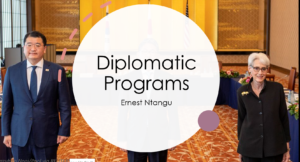 Diplomatic Programs is the account that funds U.S. State Department staffing and operations. The department supports a wide range of foreign service operations, including funding the staffing, embassy operations, and security of bureaus like African Affairs and European Affairs. Diplomatic Programs’ global reach is extensive, including 38 bureaus and offices, 195 countries, and 275 diplomatic posts.
Diplomatic Programs is the account that funds U.S. State Department staffing and operations. The department supports a wide range of foreign service operations, including funding the staffing, embassy operations, and security of bureaus like African Affairs and European Affairs. Diplomatic Programs’ global reach is extensive, including 38 bureaus and offices, 195 countries, and 275 diplomatic posts.
Diplomatic Programs deals with high-level diplomatic engagements to advance both U.S. development and security interests. The program supports diplomacy related to democracy and human rights promotion as well as arms control and nonproliferation discussions.
Through an account called Embassy Security Construction and Maintenance, Diplomatic Programs funds the infrastructure and operation costs of U.S. global embassies and consulates and other on-the-ground work to advance US interests. For example, to establish a permanent diplomatic presence in Greenland, the State Department requested funds for Diplomatic Programs. Additionally, the State Department requested funds for Diplomatic Programs to create a Watcher Unit for the United Nations Educational Scientific and Cultural Organization at the State Department.
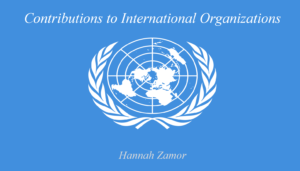 The United Nations Charter requires all members to contribute funds based on the members’ individual Gross National Incomes. The Contributions to International Organizations (CIO) account allocates these funds to UN activities and programing. The United States is the largest contributor to the UN. In 2019, the top recipients of CIO funds were: 1) United Nations Regular Budget, 2) World Health Organization, 3) Food and Agriculture Organization, 4) International Atomic Energy Agency, 5) International Labor Organization, 6) Organization for Economic Cooperation and Development, 7) Pan American Health Organization, and 8) North Atlantic Treaty Organization.
The United Nations Charter requires all members to contribute funds based on the members’ individual Gross National Incomes. The Contributions to International Organizations (CIO) account allocates these funds to UN activities and programing. The United States is the largest contributor to the UN. In 2019, the top recipients of CIO funds were: 1) United Nations Regular Budget, 2) World Health Organization, 3) Food and Agriculture Organization, 4) International Atomic Energy Agency, 5) International Labor Organization, 6) Organization for Economic Cooperation and Development, 7) Pan American Health Organization, and 8) North Atlantic Treaty Organization.
Top recipients of the CIO have projects all around the world. For example, in Chemba, Mozambique, the Food and Agriculture Organization (FAO) used its funds to support women like Anita, the leader of a women’s group of smallholder farmers. Anita explained that natural disasters and climate change often require farmers to replant their crops. Support and training from the FAO helped Anita’s community improve its seed storage techniques that keeps seeds safe from pests and rot while also allowing an increase in the variety of seeds available to farmers. The increased number of seeds allows farmers to sell seeds to other communities, providing another source of income.
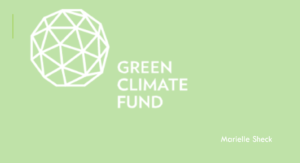 The Green Climate Fund (GCF), established during the UN Framework Convention on Climate Change in 2010, allocates resources to low-emission and climate-resilient projects in developing countries, specifically focusing on the needs of communities highly vulnerable to the effects of climate change. The GCF has a portfolio of 173 projects in every region of the world with a total value of over $30 billion. Project investments span across four categories: built environment; energy and industry; human security, livelihoods and wellbeing; and land-use, forests and ecosystems.
The Green Climate Fund (GCF), established during the UN Framework Convention on Climate Change in 2010, allocates resources to low-emission and climate-resilient projects in developing countries, specifically focusing on the needs of communities highly vulnerable to the effects of climate change. The GCF has a portfolio of 173 projects in every region of the world with a total value of over $30 billion. Project investments span across four categories: built environment; energy and industry; human security, livelihoods and wellbeing; and land-use, forests and ecosystems.
The GCF follows a county-driven approach focused on regional knowledge to assist developing countries in designing and implementing their projects. It also engages directly with the public and private sector through a network of over 200 accredited entities. The GCF is working to implement projects that will not only improve the sustainability of a region but help provide basic services for vulnerable populations such as developing community-scale solar micro-grids with battery storage in Haitian communities where currently no grid power exists. Continued investment for the GCF, particularly from higher income countries, allows the fund to accomplish its goal and work with developing countries that are disproportionately affected by climate change.
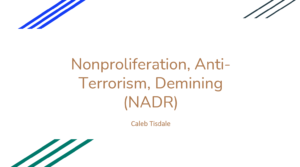 The Nonproliferation, Anti-Terrorism, Demining and Related Projects (NADR) is an important component of the State and Foreign Operations budget, particularly the International Security Assistance portion. While the most significant allocation of these funds goes towards foreign military financing, NADR programs are key to promoting international security. The three main areas that NADR programs address –nonproliferation, counterterrorism, and demining –represent collaboration between the U.S. and its allies to ensure stability outside of the Department of Defense budget.
The Nonproliferation, Anti-Terrorism, Demining and Related Projects (NADR) is an important component of the State and Foreign Operations budget, particularly the International Security Assistance portion. While the most significant allocation of these funds goes towards foreign military financing, NADR programs are key to promoting international security. The three main areas that NADR programs address –nonproliferation, counterterrorism, and demining –represent collaboration between the U.S. and its allies to ensure stability outside of the Department of Defense budget.
For example, demining programs have allocated over $4 billion in assistance to more than 100 countries since 1993. These programs are especially prevalent in post-conflict areas and consist of partnerships and training to safely dispose of unexploded mines and other weapons. Similarly, the Anti-Terrorism Assistance Program provides training courses, consultations, mentorships, and equipment to allies to bolster border security, critical incident response, and cyber security in areas vital to counterterrorism efforts.
Aside from the general purpose of fostering collaboration among its allies, this portion of the budget allows the U.S. to achieve its security goals in places where the U.S. military may not have legal authority to operate. The Nonproliferation and Disarmament Fund allows the State Department to respond quickly and effectively to nonproliferation and disarmament opportunities around the globe. NADR programs empower the U.S. to provide assistance and promote global security.
For more information about the International Affairs Budget, visit our Budget Center.
For more information about USGLC’s internship program, visit our Internships page.
Notifications